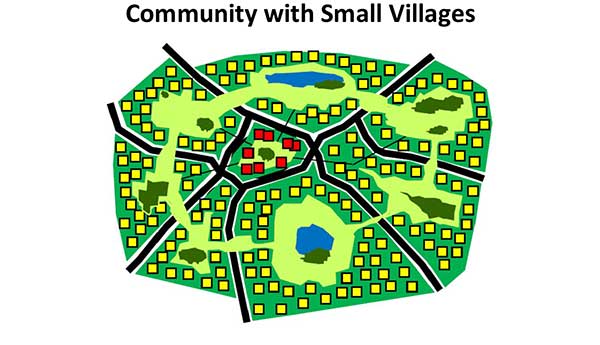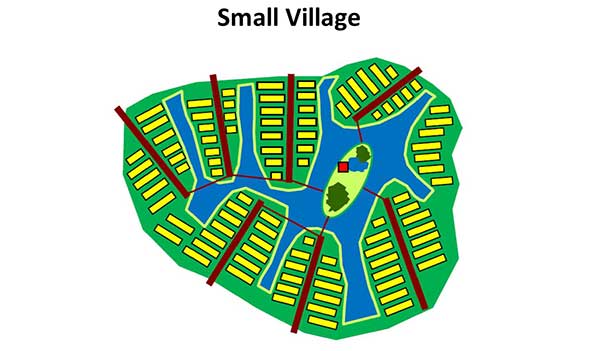 P.O. Box 941120 , Maitland , FL 32794-1120
P.O. Box 941120 , Maitland , FL 32794-1120 dmarks@cfl.rr.com
dmarks@cfl.rr.com  407.694.7040
407.694.7040
Below are some biological principles that we should apply, so we can build healthier communities, and get “Back to the Garden”.
Develop a Stable Controlled Environment that is based on Family Values - To create a healthy community, we need to create a stable controlled environment, that is supportive of the family. Living systems need to have control over what flows in and out of them. Within this environment, family values need to be promoted, so children can grow and develop, reaching their potential.
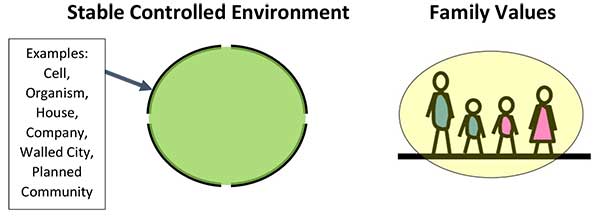
Confucius wanted to create a harmonious and stable society by moral order in the family and in the community. He believed in the “golden rule”, “never impose on others what you would not choose for yourself.” By shared values and traditions, he felt moral integrity would flourish. Confucius felt that personal desires needed to be balanced with the needs of the family and the community.
Complete Community - The community should function like a self-contained cell. As many functions, as possible should be performed within the community. Members of a community should be able to work within their community, whenever possible. Creating an environment that is more integrated. By working within their community, members will become more whole, and will be instilled with community values. Also, if you work in a community you should be able to live within it. Thus, a diversity of housing options are needed to create a complete community. By becoming more integrated the community we will become more humane. The community will see you as more than just a worker doing a job, but as a member of their group, with similar needs, values, and goals.
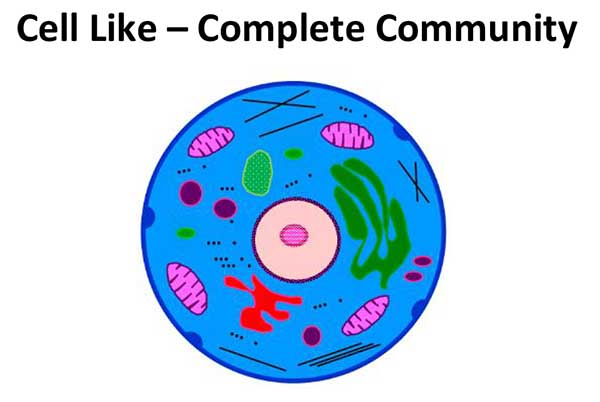
Control Center (brain) - The community will need to have a control center that functions as an organizing force for its members. Like a brain cell, the community should have a nucleus, a town center, a place where members can interact daily, meeting many of their needs for goods and services, as well as their needs for recreation, social companionship, and meaning.
More of the decisions that impact a community should be made at the community level, based on the community’s values. Decisions that are being made at a national or global level are being made by distant forces. With distance, control and order is better achieved with bureaucratic rules, then with care. These distant forces will likely be very inefficient in implementing their will. They also may be trying to exploit the communities that they oversee for their own benefit, instead of serving them. Care comes from personal interaction; aggressive control is typically imposed at a more distant impersonal scale.
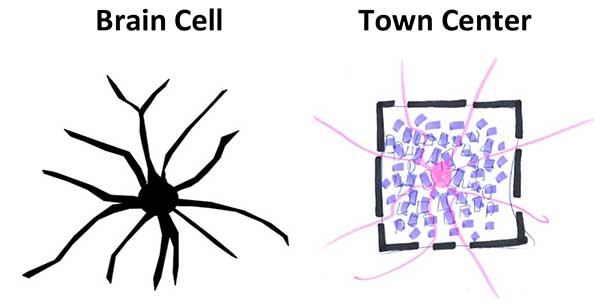
Community Integration – Community members working together to solve its problems will provide its members with greater meaning. Living systems are created to do work and solve problems. We want to be engaged in creating order. When we stop participating we lose much of the meaning that life can provide us. If we are engaged with others in our community solving problems, we are rewarded with feeling more fully alive. We are more likely to live a long and healthy life, full of meaning.
The diagram below shows an environment full of living systems. The one large living system in the middle consists of numerous smaller life forms that are working together, as a community. The value of living systems integrating can’t be denied. Look at the integrated systems of: an organism, a family, a community or city, or a corporation. Life is integration!
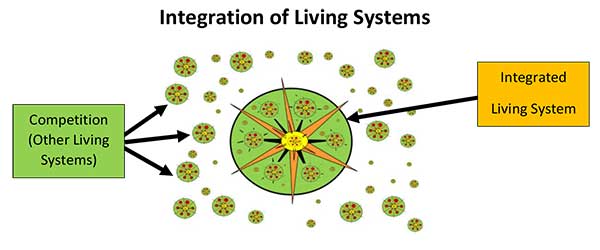
Village Density Pattern - Below is a diagram of living systems living under different density patterns. These could be living systems at any scale: cells, people, families, communities, states, etc. In the village pattern, the life forces live in a cluster in the center of their environment, preserving over 90 percent of their territory. This is a historic town or village pattern that uses the surrounding countryside for farming or hunting. In the sprawl pattern, the living systems divide up the environment equally, creating a separate environment for each organism. In this pattern the living systems become dis-integrated from each other. This pattern looks like our urban sprawl, each living system becomes the master of its own very limited enviroment. In the third case, you have a dominate life force that takes control of the environment and subjugates the rest of the community to serve its needs, in a master/slave relationship. This domination pattern is the result of a society that is focused on wealth creation, creating a have and have-not society.
The village intergrated pattern is the best pattern for us to live within. It is the pattern of our evolutionary past, and it connects us with our community and our environment.
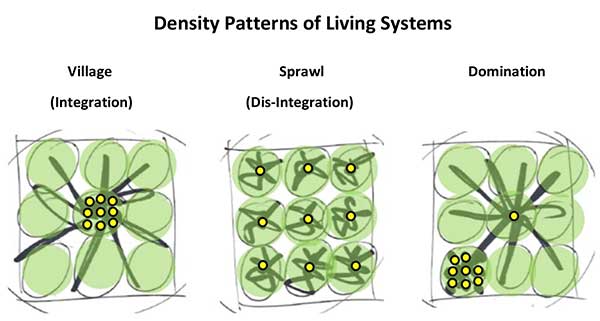
Care Zones - The mother creates a caring environment for her offspring, helping them meet their needs, as they grow and develop. That's a nice place to be, like living in a walled garden. What if we created this type of environment for our community? The integration of community life forces would help create a super-organism, that is better equipped to care for its members, creating a healthier community.
Examples of this type of caring environment are: a stay at home parent, a staffed recreation center, a school, a religious center, a small-town police department. The key to these zones of care is that there are caring people overseeing these environments, and it is at a personal scale where one on one relationships can be formed. These care zones should emerge from the community’s needs, and they should be well integrated within them. If we weave enough care zones together, we can create a quilt of care over our community.
We care for things they care about us, we care for ourselves, we care for our family and friends. If our community is caring for us, we will reflect this back, by caring about others in our community. The concept of care zones is similar to the Looking-Glass Self Concept, a social psychological concept created by Charles Horton Cooley, which basically says you see yourself as others see you. If the environment sees you as being important you see yourself as being important. If your mother sees you as being smart, you see yourself as being smart.
Below is a diagram of living systems that are working together, creating an integrated environment of care. This could be a diagram of a: family, village, institution, company, or community.
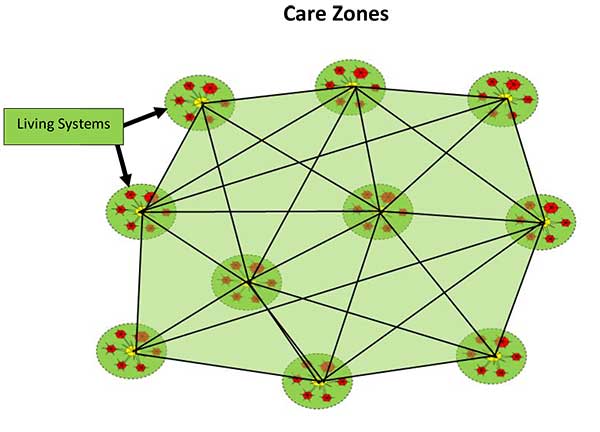
Walkable Scale - Members of a community should not have to get into an automobile to meet many of their daily needs. We should be able to reach many of our needs by walking or bicycle riding. The core of the community’s population should live within a 2-mile radius of its center, a very walkable/bike-able distance. This pattern should be similar to historic places such as: Amsterdam, Venice, Italy, or Oxford, England.
Celebration is a good example of a community that is walkable. It was developed by the Walt Disney Company; established in 1994. Below is an aerial of the main village that contains its downtown. It is isolated from the interstate highway system that is located next to it. Celebration has an extensive system of parks, and trails, that are well integrated into the community.
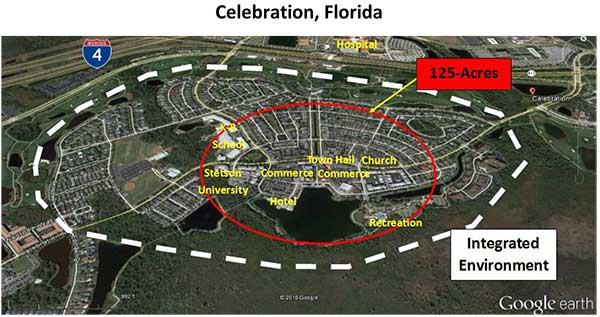
Development should have a Light Footprint on the Planet – Our communities must balance the needs and desires of the individual, with those of the community, and the environment. The telos (purpose) of community is to create an environment that promotes individual happiness and pursues the common good, in a sustainable relationship with its environment.
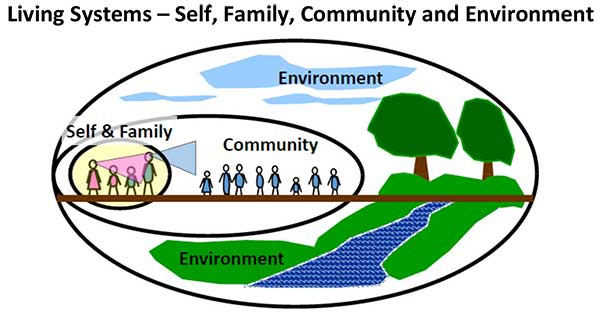
Design Community as a Garden - Baldwin Park, Orlando, Florida – Grounding breaking was in 2001. Its downtown is oriented to Lake Baldwin; the lake has a trail that encircles it. The downtown includes neighborhood retail, as well as office space and residential units. The development has numerous parks are various scales. It is heavily landscaped with trees, creating an oak tree canopy over much of the community.
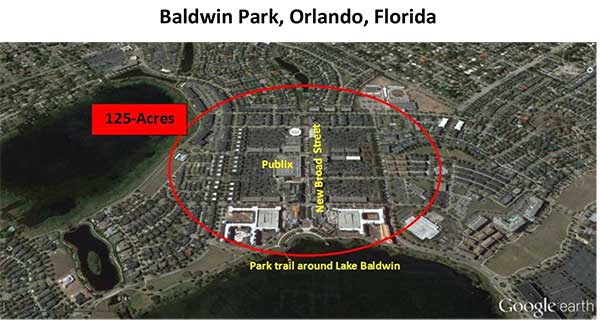
Master Plan Community at a Human Scale - What scale of life do we truly live at? Our senses are designed to function at the scale of the self, the family, and at the scale of a small village. Our five senses are not designed to perceive activity at the cellular level, or at the regional or national level. A community should be broken down into smaller villages, with each village pod being organized around its own communal space, like the squares in Savannah, or the recreational areas of a resort hotel. These public parks should be connected with each other, creating a network of natural trails within the community.
